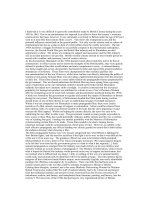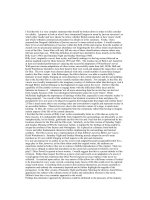the british cinema renewed itself tardily no doubt by orthodox commercial procedures
Bạn đang xem bản rút gọn của tài liệu. Xem và tải ngay bản đầy đủ của tài liệu tại đây (50.66 KB, 5 trang )
I feel that this is a very complex statement that should be broken down in order to fully consider
its validity. I propose to look at what I have interpreted Durgnat to mean by 'proven successes'; to
which other 'media' and 'new talents' he refers; whether British cinema did, in fact, 'renew' itself;
and which 'orthodox commercial procedures' he alludes to in his summary. Firstly, I have
assumed that Durgnat's definition of 'proven success' to mean critical acclaim. I would consider
there to be several definitions of 'success' within the field of film and cinema, from the number of
awards won to spectacular audience attendance not forgetting the box office return on production
costs of the film. Some films will only fall into one of these classifications whereas others may
fall into more than one. With this definition in mind I have decided to focus mainly on the films
Billy Liar! (1963) and Saturday Night and Sunday Morning (1960) .
Billy Liar!, originally a novel, then a play, and finally making it to the big screen followed an
almost standard route for films between 1959 and 1963. The London run of Billy Liar! lasted for
at least six hundred performances1 enjoying the successful adaptation of Waterhouse's novel.
With previous cinema adaptations of other writers successfully under their belt, Willis Hall and
Keith Waterhouse decided to turn their hand to their own work and adapted the stage play's script
for film. The two scripts were almost identical with only a small number of censorious changes
made to the film version. John Schlesinger, the film's director, was able to explore Billy's
fantasies in more depth, bringing an extra dimension to the central character and his surroundings
due to the fact that film is a far more versatile medium than theatre. For example, in the film, the
viewer was visually transported to the imaginary country of Ambrosia rather than having to visit it
through Billy's internal dialogue as had happened on stage and in the novel. I believe that this
capability of film enables viewers to engage better with the difficulties Billy faces and the
fantasies he dreams of. Adaptations 'are all more interesting than the novels they are derived
from, largely because of the way ideological information seeps into every frame.' Brian
McFarlane highlights the importance of ideology within film, especially in one whereby 'reality' is
being projected. 'As a result of the unobtrusive but insistent evocation of time and place, the
protagonists' lives are seen to be played out against the backgrounds that shape and confine them:'
2 Film is much more able to use existing codes and conventions to signify and represent society in
an accessible fashion. Theatre however, due to the restrictive nature of a stage, is much more
limiting. In film, the viewer can be transported into the community rather than having to imagine
certain aspects of the life of the central character.
I feel that the film version of Billy Liar! works considerably better as a film than as a play for
these reasons. It is indisputable that Billy feels trapped by his surroundings, not physically so, but
metaphorically, by his family, girlfriends and his own lies and I feel that this is epitomised by the
locations chosen for the film and the film style. Similarly, in the film version of Saturday Night
and Sunday Morning (1960) the male lead, Arthur, is trapped by his feelings of being unable to
escape the confines of the factory and Nottingham. He is placed at a distance from both the
viewer and other fundamental characters further emphasising his surroundings and internal
conflicts. The film is not as true a representation of Alan Sillitoe's novel as Billy Liar! was to
Keith Waterhouse's. Saturday Night and Sunday Morning merely adopts the novel's main
incidents as it's own whilst bringing in fresh aspects to the plot and characters.
It is not uncommon for an author to see his or her work adapted beyond recognisable belief for a
stage play or film, however, as the films often credit the original writer, the audience are
sometimes misled to believe they are to witness a faithful reproduction of the original. 'Only too
often one is obliged to admit that translation to the screen has coarsened or blurred a novel or
play'3 Dilys Powell is quoted to have written. I would suggest that this is a purist attitude to film
criticism. Rather than respect the film as a piece of art unto itself, as an adaptation of a novel, it
would appear from this statement that Dilys Powell expects an exact replica of the novel on
celluloid. As touched upon earlier, the very nature of film allows for a different version of 'reality'
to be presented in every scene viewed, connoting many facets of life that could never be captured
using words alone. Everything from accents to the locations themselves are chosen carefully to
emphasise and embody the community depicted and to further highlight the anguish of the
protagonist. In the film version of Saturday Night and Sunday Morning the director, Karel Reisz,
approaches his subject with a distinct sense of reality and rationalism whereas in the novel,
Sillitoe's hero has a very romantic approach to the world.
Perhaps this alternative approach by directors could be attributed to the pressures of the industry
and audiences in the late 1950s. During this time, critical praise was heaped upon the films of the
New Wave due to their perceived 'realism'. These films, representing real life and real issues,
were seen to be cultural reflections of the time, exemplifying the high artistic values and
capabilities of the British film industry. In his leaflet, Realism or Tinsel, Michael Balcon gave his
views on the construction of contemporary films. He approved of the documentary techniques
adopted in the 'kitchen sink' style dramas of the era and degraded those films made purely for
entertainment purposes. Hollywood equated with 'tinsel', the glamour and theatrical style of films
that really represented little other than a distraction. It should be remembered however that whilst
critical opinion matched that of Balcon, it represented a very middle class attitude of the industry
at the time, and whilst the influence of critics can be very persuasive it does not always guarantee
the success of a film. In her book British Genres, Cinema and Society, 1930-1960, Marcia Landy
categorises the reasons as to why realism was critically better received than anything else at that
time. It was believed '(1) that realism is an unchanging essential phenomenon, (2) that realism is
superior to genre production, (3) that the strengths of British cinema reside in realism, and (4) that
films are a "reflection" of life.'4 In contrast to the realism being produced on home soil,
Hollywood was seen to be turning out the 'tinsel', films of no real substance, purely entertainment.
During the period Durgnat mentions in the earlier quote, 1959 to 1963, the British film industry
was still undergoing change. Experiencing some remaining turbulence caused by the Second
World War, this period continued to see outside influences affect the medium in such a way that
would forever label these four years as the British New Wave. This stage of British cinema's
history was characterised by a new focus on working class life, more specifically on the Northern
working classes. With a filmic style firmly based on Grierson's documentary movement of the
1930s, these films had a refreshing gritty realism that was both new and exciting. Loosely
associated with the Independent Group of artists, architects and critics, this innovative group of
'New Wave' filmmakers had strong theatrical and literary roots. Tony Richardson, Karel Reisz
and Lindsay Anderson were all originally theatre directors, making their first documentaries in the
mid 1950s and progressing onto feature films during this innovative period. Both groups were
determined to forge an original style in their respective media, the New Wave looked at the very
essence of England and its communities whilst the Independent Group grasped the idea of
Americanism and its consumerism. Whilst this was the beginning of Pop Art, with its young,
witty, sexy and gimmicky approach to brash subject matters, the film world was doing almost the
reverse. Equally outspoken about the social construction of society the New Wave focussed on
emotions and realistic representations of daily life. To further emphasise their modern approach
many of these directors chose actors that were previously unknown in the cinema. It was felt that
they were able to project a more 'authentic' reality onto the screens as they had been untarnished
by 'star' status. The protagonists of this New Wave of films enabled viewers to focus on the film's
subject matter and the values of working class life that were embodied within the film. Often
rebelling violently to society these modern day heroes were labelled the 'Angry Young Men',
another phrase that was later adopted for the cycle of films. With their rejection of society and
feelings of anti-establishment these 'Angry Young Men' reflected an increasing divide between
society's disillusioned young adults and their communities. The realism portrayed in these New
Wave films represented genuine contemporary issues in a way that had previously been left
untouched by cinema.
Further assisted by the more relaxed censorship values of John Trevelyan, filmmakers were now
able to tackle real issues of promiscuity, sex, nudity and abortion in an adult fashion. Trevelyan
had decided that, to prevent censorious cuts, he would award these films an 'X' certificate. He had
hoped that this new cycle of films, critically defined as 'quality' because of their realism, would
help to improve the image of the 'X' rated film which was previously associated with the
sensational and exploitative horror genre. Directors greeted this new policy with open arms. The
New Wave was ideally suited to adapt to these new regulations as the relaxed censorship enabled
further exploration of real issues. Billy, in Billy Liar!, makes open references to his girlfriends of
his feelings for them, in one particular instance offering Barbara 'passion pills' to encourage her to
sleep with him. However, in the case of Liz, scenes that had been passed for the theatrical play
had to be cut before the film could be shown to cinema audiences as they were deemed to be too
contentious.
I feel that this relaxation of censorship could be indirectly classed as one of the orthodox
commercial procedures to which Durgnat refers. Whilst censorship was something that the
filmmakers had no control over, the relaxed laws undoubtedly led to an increased attendance to
many films especially those promising sexual excitement. Previously any suggestion of sex in
films had come from European 'art house' cinema, whose films had almost extensively been
restricted to screenings in adult cinemas. The relaxation of British laws, however, should not be
misread to imply that laws were being adapted to try to remodel the film industry or society.
However, a desire to produce films with more colloquial, and sometimes coarse, dialogue and
texts with a slightly more adult subject matter did assist the development of new broadcasting
laws. Many of the key acts in British history were passed during the 1960s as a direct result from
pressures within the society that they were created to protect.
In an attempt to further help the British film industry grow during this of surge of activity, and
once again outwith the control of the filmmakers themselves, the UK government took measures
to encourage foreign film companies to enter the British commercial market. By reducing the cost
of filmmaking in Britain many French, Italian and American filmmakers produced films in Britain
using our studios and technical crews. As a direct result of this incentive, Harry Saltzman and
Cubby Brocolli made Dr No (1962) the first of a long and successful line of James Bond films.
Again, first being published as a novel in 1958 by Ian Fleming, the current formula of British
filmmaking was being used again albeit by an American. Whilst Dr. No was not part of the
'Angry Young Men' cycle, these directors ' plainly put film second. Their success was directly
derived from the success of the original plays and novels by Osborne, Amis, Braine and Sillitoe.
Look Back in Anger, Room at the Top, The Entertainer, A Taste of Honey, Saturday Night and
Sunday Morning, and The Loneliness of the Long Distance Runner came out in their original
forms between May 1956 and September 1959. The film versions, which came out after a three
year interval, between 1959 and 1962, clearly depended on the prepublicity and acclaim already
generated by their literary sources for their initial impact.'5 Peter Wollon is very critical of the
films made between 1959 and 1963, as is Raymond Durgnat, as reflected in his opening statement.
Neither seem to consider that in this period cinema attendances had dropped dramatically and,
with increasing competition from television, perhaps it was wiser for directors to stick with the
tried and tested genre of literary adaptations. It certainly wasn't a new discovery to adapt novels
and stage plays, Brighton Rock (1947) started its life as a novel by Graham Green as did Bram
Stoker's Dracula, which had more cinema adaptations prior to 1960 than I care to mention.
Nonetheless, audience tastes seemed to be progressing from the dramatic adaptations of previous
years to real depictions of society. The chief executive of Anglo-Amalgamated, Nat Cohen, 'did
feel the change in audiences' tastes taking place at that time - for one thing, television was
reflecting back into their own living rooms a much more realistic picture of the lives they led
outside.'6 With this in mind, cinema had to try to increase its competitive edge by giving
audiences what they wanted in terms of the realism that television was offering plus the subject
matters that television was not yet able to provide.
I believe that the ultimate factor defining the breakthrough of cinema during the New Wave was
the change of focus from the working classes as comedic entertainment to socially integrated and
hardworking, members of society with their own aspirations. The main core of the films made
during the period 1959-1963 were adaptations of literary works and they were produced using
styles taken directly from other sources. However, the British film industry was once again about
to face a further collapse if measures were not taken to support it. To say that the industry
'renewed itself, tardily' can only really refer to the fact that the rest of Europe, especially France,
had already initiated a revival of it's own. Always a follower and never a leader, Britain was slow
to adapt to the new techniques of the 'Nouvelle Vague' in France. Nonetheless, the industry was
reborn, if only for a short time, under its current guise. A stimulating era which, in later years,
influenced a new cycle of films termed 'Brit-Grit', evolving in the late 1980s, early 1990s.
Notes.
1.Anthony Aldgate, Censorship and the Permissive Society: British Cinema and Theatre,
1955-1965 (Oxford: Clarendon Press, 1995), p.146
2.Brian McFarlane, 'A Literary Cinema? British Films and British Novels', in All our Yesterdays -
90 Years of British Cinema, ed. by Charles Barr (London: BFI, 1986) pp. 120-42 (p.138)
3.Christopher Cook, ed., The Dilys Powell Film Reader (Manchester: Carcanet Press, 1991) p. 21
4.Marcia Landy, British Genres Cinema and Society, 1930-1960 (Princeton: Princeton University
Press, 1991) p.50
5.Peter Wollon, 'The Last New Wave: Modernism in the British Films of the Thatcher Era', in
British Cinema and Thatcherism. Fires were Started, ed. by Lester Friedman (London: UCL Press,
1993), pp. 35-51 (p.37)
6.Nat Cohen. Alexander Walker, Hollywood, England. The British Film Industry in the Sixties
(London: Michael Joseph, 1974/Harrap, 1986) p.112
Bibliography.
Aldgate, Anthony, Censorship and the Permissive Society: British Cinema and Theatre,
1955-1965 (Oxford: Clarendon Press, 1995)
Aldgate, Anthony and Jeffrey Richards, eds., Best of British. Cinema and Society from 1930 to
the Present (London: IB Tauris, 1999)
Barr, Charles,ed., All Our Yesterdays - 90 Years of British Cinema (London: BFI, 1986)
Cook, Christopher, ed., The Dilys Powell Film Reader (Manchester: Carcanet Press, 1991)
Ellis, John, Visible Fictions Cinema:Television:Video (London: Routledge & Kegan Paul, 1982)
Jordan, Marion, 'Carry on Follow that Stereotype', in James Curran and Vincent Porter,
eds.,British Cinema History (London: Wiedenfield and Nicolson, 1983) pp.312-27
Landy, Marcia, British Genres : Cinema and Society 1930 - 1960 (Princeton: Princeton University
Press, 1991)
McFarlane, Brian, 'A Literary Cinema? British Film and British Novels' in All Our Yesterdays,
pp.120-42
Murphy, Robert, Realism and Tinsel: Cinema and Society in Britain 1939-1949 (London:
Routledge, 1989)
Murphy, Robert, Sixties British Cinema (London: BFI, 1992)
Park, James, British Cinema - The Lights that Failed (London: BT Batsford Ltd, 1990)
Russell, John, Intro. Masterworks of the British Cinema (London: Taylor Lorimer Publishing,
1974)
Porter, Vincent, 'The Context of Creativity: Ealing Studios and Hammer Films',in British Cinema
History, pp.179-207
Quart, Leonard, 'The Religion of the Market: Thatcherite Politics and the British Film of the
1980s' in Lester Friedman, ed., British Cinema and Thatcherism. Fires were Started (London:
UCL Press, 1993) pp.15-34
Street, Sarah, British National Cinema (London: Routledge, 1997)
Walker, Alexander, Hollywood, England. The British Film Industry in the Sixties (London:
Michael Joseph, 1974/Harrap, 1986)
Wollen, Peter, 'The Last New wave: Modernism in the British Films of the Thatcher Era', in
British Cinema and Thatcherism. Fires were Started, pp.35-51
Filmography.
Billy Liar! (1963)
Saturday Night and Sunday Morning (1961)









